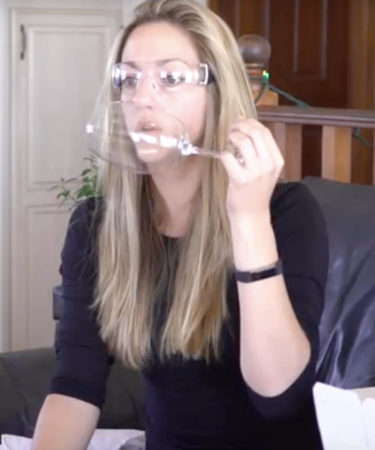Be careful at karaoke. According to science, you can actually shatter a wine glass with your voice. The trick is, it has to be the perfect pitch.
Dianna Cowern, also known as Physics Girl, proved this theory in a recent video on her YouTube channel.
Her inspiration was threefold: MIT conducted an experiment several years ago in which they broke a wine glass using audio speakers. In their test, an Audio Resonance Function generator powered a speaker beside a wine glass, and as the vibrations in the air (AKA, the sound) vibrated the glass, the person conducting the experiment “tuned” the function generator to the glass’ resonance frequency and turned up the volume, leading to the glass shattering.
Later, Mythbusters conducted a similar experiment with a trained vocalist who was also able to break crystal glasses with his voice.
After fellow YouTuber, Mike Boyd tried it out on his channel, Physics Girl decided it was time to try it for herself– to see if a wine glass could be broken with a “raw, untrained human voice” (hers)–and to dig a little deeper to find the science behind the phenomenon.
How to Break a Wine Glass With Your Voice
So, she says, think of a wine glass as an oscillating system: it moves back and forth, or vibrates. By finding the right resonance frequency of a glass and singing loudly at that tone, the glass will vibrate and eventually break.
(One way to find the resonance frequency is by flicking the glass and matching the pitch you hear when it vibrates, then singing at that pitch as loud as you can with an annoying “eee” sound. Tone deaf? Physics Girl suggests trying “sweeping noises” to find the right pitch, which totally works: see her do it here, at 1:40, and then again, in slow motion, at 4:15.)
It all has to do with resonance frequency and analog.
A good example of this is what Cowern refers to as the “playground swing analogy.” The resonant frequency of the swing is the frequency your swing will keep swinging at if you stop pumping your legs. To swing higher and higher, you’ll want to be pushed at the exact right time: that moment after you oscillate backward and before you swing forward again. That exact moment is the “analog” of the swing.
With the wine glass, the resonance frequency is the note at which the glass will vibrate, or the pitch you hear when you flick it or tap it with a fork and let it ring. To reach the analog, you must sing at that exact frequency, loudly (and possibly for a long time), and just like you’d swing higher and higher on the swing set as you were pushed, the glass will vibrate harder and harder as you push it with your voice.
It can be difficult to do, so one way to make it easier is to find a glass with a scratch or crack (or to make a tiny scratch in the top of the glass). The glass doesn’t have to be crystal, but you’ll want a glass that rings when you flick it, and one that has a thin rim, so it will deform more easily. If the glass is new and has no scratches, you’re going to have to sing for a long time, which gets really annoying. (See Cowern tackle this at 6:55, when she uses a brand new glass made of crystal, and noise canceling headphones to block out her own voice.)
Now we know the science behind how the glass breaks. But why does it break? Shouldn’t your glass be strong? Cowern recruits friend and mechanical engineer, Kyle Kitzmiller to explain: one theory is that as you’re singing and the glass is vibrating, tensile stress (stress leading to expansion; or tension) on any existing cracks will stretch those cracks and cause them to gradually grow, until they reach critical crack length and cause a brittle fracture (that’s when you have a lap full of glass).
Another explanation is that reaching that perfect pitch can take a while, but once you get to it–to a resonance so great, the tensile stress exceeds its critical level—the glass shatters.
So, you know, don’t try this at home. But if you do, wear safety goggles, have a first aid kit handy, and maybe don’t do it near carpets. Cleaning glass out of carpets is really annoying.
